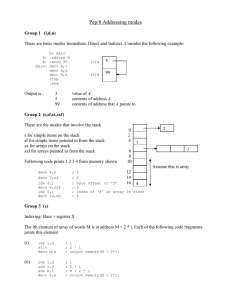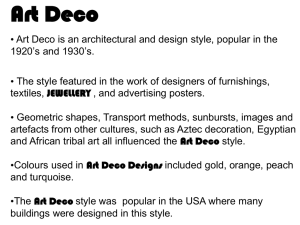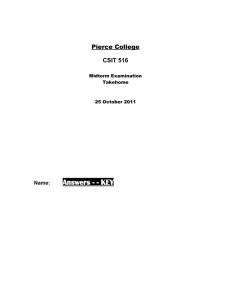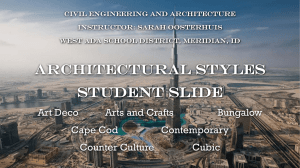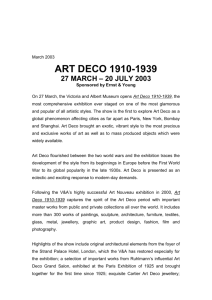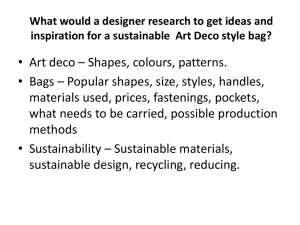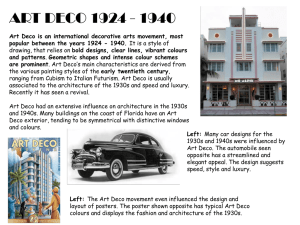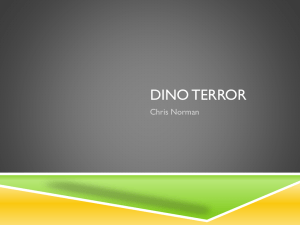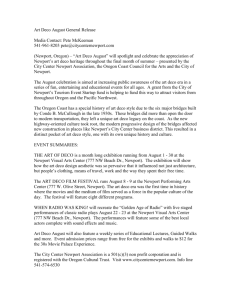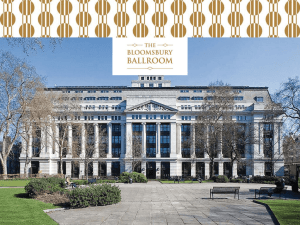ART DECO - Deganutti
advertisement
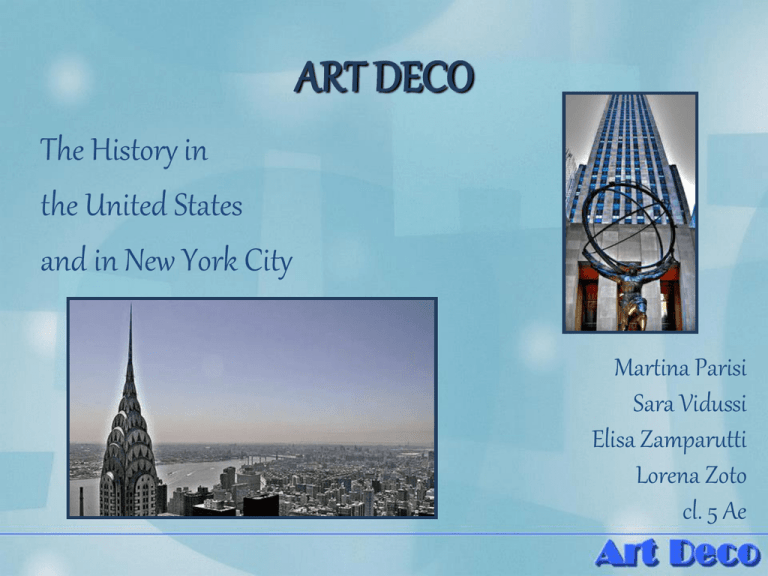
ART DECO The History in the United States and in New York City Martina Parisi Sara Vidussi Elisa Zamparutti Lorena Zoto cl. 5 Ae What is Art Deco? Art Deco is an eclectic artistic and design style which had its origins in Paris in the first decades of the XX century. It was originated in the 1920s and continued to be employed until after World War II. Detail of Paris’ underground The term “Art Deco” first saw wide use after an exhibition in 1966, referring to the 1925 Exposition Internationale des Arts Décoratifs et Industriels Modernes. Where we can find it? DECORATIVE ARTS fashion, jewellery and interior design DESIGN architecture and industrial design VISUAL ARTS painting, graphic arts and film Features Its popularity peaked in Europe during the Roaring Twenties and continued strongly in the United States through the 1930s. Although many design movements have political or philosophical roots or intentions, Art Deco was purely decorative and had a profound influence on many later artistic movements, such as Memphis and Pop art. Art Deco in the USA Lots of buildings from 1920 to 1939 are within the Art Deco tradition. Some examples in New York, Chicago, Los Angeles and in California. Miami Beach, Florida Florida has got a large collection of art-deco buildings, with hotels and apartment houses from 1920s to 1940s. The Architectural Historic District was listed on the National Register of Historic Places; all the buildings have been restored and painted in their original pastel colours. Texas Houston City Hall Air Terminal Museum Kansas City The Kansas City Power and Light Building. This building is the main example of the Great Depression and its effect in Art Deco construction. Municipal Auditorium Jackson County Courthouse Kansas City City Hall Cincinnati The Cincinnati Union Terminal is an Art Deco style passenger railroad station that, after the decline of the railroad travel, was converted into the Cincinnati Museum Center. This town is also home of the Carew Tower which is an Art Deco skyscraper built in 1931. New Jersey Its most important building is the Jersey City Medical Center. California One of the surviving examples of the Art Deco style is the RMS Queen Mary, which is currently moored in retirement in Long Beach as a floating museum and hotel. Reminder of the past glory of the once numerous trans-Atlantic ocean liners of the Art Deco period. General features Art Deco has been influenced in part by movements such as Cubism, Russian Constructivism and Italian Futurism which are all evident in Art Deco decorative arts. Cubism Russian Constructivism Italian Futurism Art Deco was also influenced by nature and historical monuments. For this reasons, we can find references to African, Greek and Egyptian art, the Ziggurat (babylonian pyramid), tropical leaves, solar jets, cristals, female shapes (thin and agile). Materials and design Art Deco is characterized by use of materials such as aluminium, stainless steel, lacquer, Bakelite, Chrome and inlaid wood. Exotic materials such as sharkskin and zebra skin were also in evidence. The bold use of stepped forms and sweeping curves, chevron patterns, the fountain and the sunburst motif are typical of Art Deco. Some of these motifs were ubiquitous: for example, sunburst motifs were used in such varied contexts as ladies' shoes, radiator grilles, the auditorium of the Radio City Music Hall and the spire of the Chrysler Building. Some examples American standard (radiator) building Date: 1923-1924 Style: ART DECO Type: Office-Building The black brickwork on the facade was chosen to lessen the visual contrast between the walls and the windows. The Gothic-style pinnacles and terra-cotta friezes on the edges of the setbacks are coated with gold. The base is clad in bronze plating and back granite. There are carved allegories, symbolizing the transformation of matter into energy,quite appropriate for a heater company. The entrance lobby is decorated with black marble and mirrors. Chanin building Date: 1927-1929 Style: ART DECO Type: Office building The steel frame is clad in buff brick and terra-cotta. The facade illustrates the introducion of colored glass, stone and metal on the exterior of tall buildings. Material such as bronze, Belgian marble and terra-cotta are used in an inventive way. Bronze gate leading to Irwin Chanin's offices, designed with symbolic ornament representing individual aspects of the greatness of New York City. Stylized figure that represents some aspect of either the intellectual or the physical life. Web References • • • • www.retropolis.net www.foxnews.com www.1920-30.com www.nyc-architecture.com
